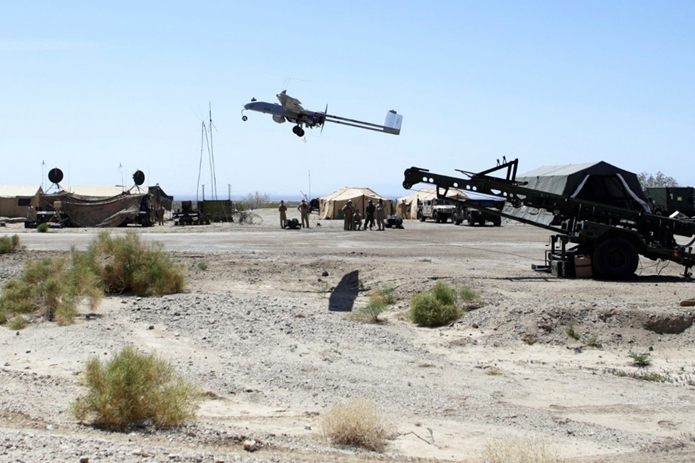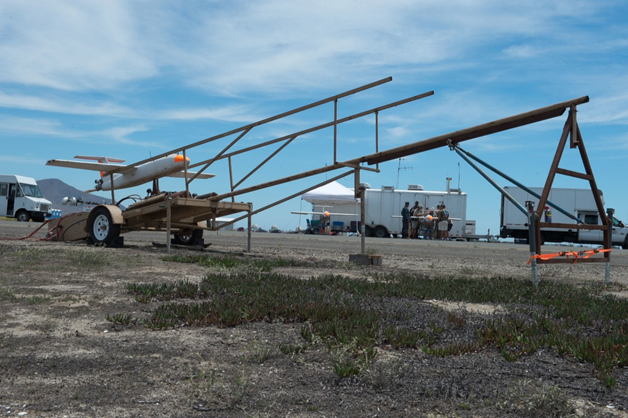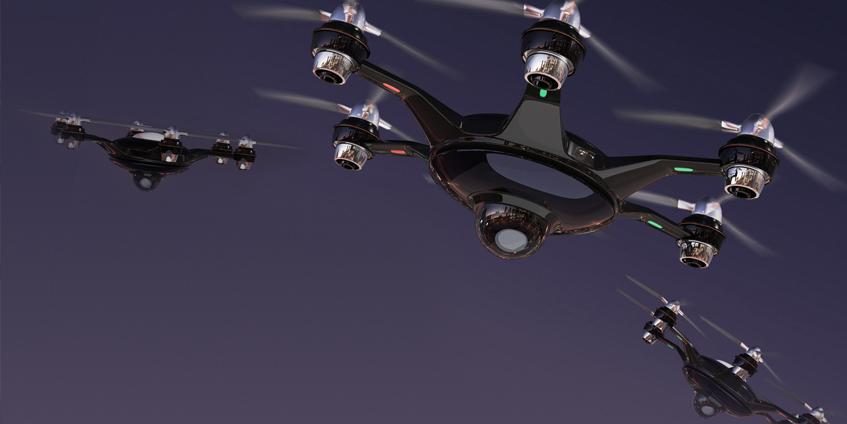BACKGROUND
As technology advances and the U.S. military touts the advantages of unmanned aircraft systems (UASs) (such as that pictured in Figure 1) for use in combat, a resounding fact is that other countries, terrorist organizations, and criminals are sure to continue to develop and procure low-cost UASs themselves. Often, these small, complex systems are equipped with cameras, laser designators, radio frequency (RF) collection devices, and/or weapons to provide battlefield intelligence and engage friendly forces. The size and composite materials used in UAS production make them inherently difficult to defeat with traditional force protection measures and short-range air defense (SHORAD) systems commonly employed by brigade and below maneuver forces.

Figure 1: RQ-7B Shadow Launch During Exercise (U.S. Marine Corps photo by Chief Warrant Officer 2 Jorge Dimmer).
One of the most significant uses of unmanned systems on the battlefield today is occurring in Ukraine, where both Ukrainians and Russian-backed separatists are operating UASs in relatively large numbers. These warfighters are reportedly operating more than a dozen variants, including fixed- and rotary-wing configurations, each functioning at different altitudes with various sensor packages designed to complement each other’s capabilities.
And the battlefield is not the only susceptible area to the effects of nefarious UAS operators. The U.S. capital, nuclear facilities, correctional facilities, borders, and sporting venues are among the localities already infiltrated with this rapidly proliferating technology. Terrorists leverage UASs to interrupt our daily routine, while criminals defeat traditional security (e.g., fences, walls, and “no-fly” zones) to scout low-risk routes for illegal alien and drug transport across the border and contraband delivery to prisoners. While these are not traditional military missions, Department of Defense (DoD) specialized equipment and personnel may be tasked to support civil agencies in the Defense Support to Civil Authorities (DSCA) construct.
For nearly 3 decades, the U.S. Army and unified action partners have had the luxury of conducting ground and air operations in a virtually uncontested airspace environment. As such, development and fielding of dedicated SHORAD systems have declined and passive air defense skills have atrophied across the force. However, continued UAS technology development, UAS fielding acceleration, and the “bad actor” successes around the world clearly demonstrate that we are faced with a viable air threat. Leaders at all levels cannot be lulled into a false sense of security because of the small size of these UASs. They are as effective, if not more effective, than traditional manned aircraft (or even stealth aircraft) in reconnaissance, surveillance, and target acquisition (RSTA); precision attack; and indirect fire support. In short, troops must assume they are being continually watched and targeted and take appropriate action to minimize mission impact.
WHAT LEADERS AND WARFIGHTERS NEED TO KNOW
UASs can create serious problems for maneuvering or static forces. Their size, composite construction, small radar and electromagnetic signatures, and quiet operation make them difficult to detect and track. Their low cost, lethality, and rampant proliferation make them an air threat that we can no longer ignore.
Accordingly, focused counter-unmanned aircraft system (C-UAS) awareness, understanding, and training, (such as the exercise pictured in Figure 2) are needed by today’s military planners and leaders.

Figure 2: Target Drone Ready for Launch During a C-UAS Live Fire Exercise (U.S. Navy Photo by Petty Officer 2nd Class Antonio Turretto Ramos).
Factors contributing to the C-UAS challenge include the following:
- Small, slow, and low profiles provide significant challenges to traditional air defenses. Conventional systems often filter out these tracks to avoid confusion with clutter, large birds, and aerostats. Systems optimized for this threat often forfeit effectiveness against other target sets (e.g., manned aircraft, cruise missiles, rockets and mortars, and ballistic missiles).
- Reduction of dedicated SHORAD units to maneuver brigades creates potential gaps in air defense coverage.
- Warfighters are largely indifferent to UASs. Recent combat experience in Iraq and Afghanistan indicates troops may become highly accustomed to friendly UASs and, therefore, less likely to be concerned about them flying overhead and less inclined to actively search for UASs operating in their battlespace.
- Many warfighters lack UAS recognition training. Without training, it is extremely difficult to observe characteristics visually, which can easily distinguish threat UASs from friendly systems supporting the mission. This issue is compounded by the ever- increasing proliferation of new UAS designs and off-the-shelf systems sold to a number of countries.
- U.S. Army and Joint doctrine have not kept pace with the threat.
Simply put, C-UAS training is not a priority for many units, and thus they have not adequately updated plans to address the hazards that UASs present.
UNDERSTANDING THE THREAT
UASs pose a significant threat to safety and mission accomplishment by providing the enemy critical intelligence, such as a unit’s precise location, composition, and activity. UASs may also provide laser designation for indirect fire or direct attacks using missiles; rockets; small guided munitions; or chemical, biological, radiological, and nuclear (CBRN) weapons. Some payload configurations can contain radar and communications jamming or other cyberattack technology. UASs may operate autonomously with little or no RF signature or under pilot control using a ground control station (GCS).
With regard to threat characteristics, UASs:
- Are typically composed of a UAV, a sensor and/or weapons package, a GCS, and communications equipment to support navigation and data transfer.
- Are available on the open market, are often clones of U.S. systems, and are less expensive than stealth technologies.
- Often rely on a global positioning system (GPS) for guidance/targeting and can use multiple RF bands, including frequency modulation (FM), ultrahigh frequency (UHF), satellite communications (SATCOM), and cell phones.
- Often have a limited range and flight duration (especially small UASs), meaning they are frequently operated from within the observed unit’s battlespace.
THREAT MITIGATION
To mitigate risks associated with any air threat requires the performance of a comprehensive air threat analysis as part of the Intelligence Preparation of the Battlefield (IPB)/Intelligence Preparations of the Environment (IPE), as well as the leverage of any and all available resources. Furthermore, defeating the UAS threat begins with the following planning process:
- Understanding the UAS threat – Conducting a deliberate analysis to ascertain the potential UAS type and GCS likely to be employed, understand their capabilities and employment doctrine, predict where and how they will be employed, and identify their most likely targets.
- Honoring the threat – Ensuring there are adequate/appropriate resources to counter UAS effects in and around a unit’s battlespace. If specialized sensors are not available, “air guards” should be established to continuously scan the airspace. Additionally, planners must ensure they understand and are in compliance with the Area Air Defense Plan (AADP).
- Maintaining disciplined flight operations – Although flight clearances for friendly UASs are sometimes perceived as untimely or overly restrictive, they are critical to ensuring other friendly forces in the area do not engage those UASs. Planners/operators must ensure that flights are in compliance with all local Airspace Coordinating Measures (ACMs) to aid in proper identification (ID).
C-UAS CONSIDERATIONS
UASs are the air threat of the next fight. As mentioned, UAS technology development and employment around the world demonstrate a relevant and viable air threat. And the defense community cannot be lulled into a false sense of security because of the relatively small size of these platforms. Air defense artillery liaison officers should thus consider the following actions when working with/within the Integrated Air Defense System (IADS):
- Take an active role in AADP development to ensure it adequately mitigates threats to the maneuver force.
- Suggest UAS-specific rules of engagement (ROE) when there is a reliable ability to distinguish unmanned platforms to maximize attrition of low-regret targets. ID and engagement authority for low, slow, small UASs should rest at the lowest possible tactical level.
- Ensure that criteria for “hostile act” and “hostile intent” that specifically address UASs are written in terms any warfighter can understand and adequately address ground troop protection.
- Consider requesting liberal “hostile” symbology use and ID forwarding through the Air Defense and Airspace Management (ADAM) Cell to the Common Operational Picture (COP).
- Ensure all Joint data link contributors use a common set of track amplification data (e.g., air type, air platform, and air activity) to categorize the UAS target set.
NATIONAL CAPITAL REGION AND INTERAGENCY SUPPORT
Critical assets within the continental United States have already been “attacked” by nefarious UAS operators. While no deaths have been attributed to these UASs, it is only a matter of time before these systems are directly or indirectly responsible for loss of life or interference with critical infrastructure in the homeland. In some circumstances, Title 10 military personnel and equipment may be required to operate subordinate to civil-military organizations. The following are considerations for personnel working in this environment:
- Per Department of Defense Directive (DoDD) 3025.18 [1], DoD resources may be used in an immediate response to prevent loss of life, mitigate damage to infrastructure, or support mutual aid agreements (Title 42 USC) to address certain precoordinated conditions, or as directed by the President as part of the national response framework.
- All DoD activity within the homeland is conducted to support a primary federal agency to minimize impacts to the American people, infrastructure, and environment.
- It is unlikely that most organic communications systems will be compatible with the civil organization(s) being supported, thereby increasing reliance on knowledgeable liaison officers.
- Missions may include air defense coverage for the National Capital Region (NCR), key power/communications infrastructure, national borders, sporting arenas, political conventions, and Presidential inaugurations.
- Technology countering the UAS threat within U.S. borders must be in compliance with existing Federal Aviation Administration (FAA) and Federal Communications Commission (FCC) regulations. Military planners cannot assume they are exempt from fines or prosecution for violating civil airspace or spectrum management policies in the interest of thwarting a potential hazard.
CONCLUSION
UAS development and fielding are gaining momentum with our adversaries, and with each new innovation, these adversaries are becoming more capable than their previous generation. We must assume localities of vital interest are being watched and targeted. In addition, UAS operations are not limited to the battlefield; they have already been used to disrupt our daily routines at home and violate traditional security measures surrounding our borders, prisons, nuclear facilities, premier sporting venues, etc. Accordingly, leaders across all warfighting functions must take an active role in educating themselves and training their units to defeat this threat. Civil authorities should also be kept aware of the defense industry’s ongoing research and analysis in the area and should be encouraged to both leverage the latest military technology and request assistance in defending airspace around sensitive domestic localities.
References:
- U.S. Department of Defense. Defense Support of Civil Authorities (DSCA), Change 1, DoDD 3025.18, 21 September 2012.


